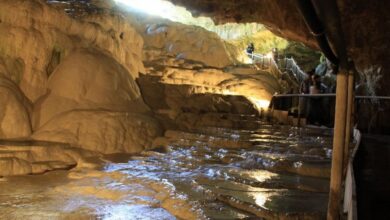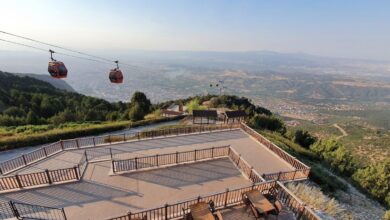Pamukkale And The Ancient City Of Hierapolis

Pamukkale and the ancient city of Hierapolis are one of the best touristic places in Turkey. Pamukkale and the ancient city of Hierapolis are visited by millions of people every year.
You should spare 1 day to visit Pamukkale and the ancient city of Hierapolis. This is a big area. Especially if you are visiting this place in the summer, you should definitely take extra cold water with you.
Table of Contents
Travertines of Pamukkale
Pamukkale travertines, tourists from all over the world come to see the travertines. In addition, the waters in the travertine pools are healing. The healing waters are known to help cure many diseases. Many tourists stay at hotels near Pamukkale. They buy a museum card and visit the pamukkale every day.
In general, vacationers only come to see the hot springs. They are unaware of the existence of the ancient city, and some do not want to visit this place. But people who know how important the ancient city of Hierapolis was in history, spend a lot of time here.
There are religious buildings in the ancient city of Hierapolis. Therefore, Hierapolis is also known as the holy city.
Pamukkale And The Ancient City Of Hierapolis
Hierapolis is a stunning ancient city dating back to the 2nd century BC. It combines nature, civilization with travertine terraces. The city collapsed significantly after two earthquakes in 60 AD. and in the 17th century A.D. The damaged buildings have been renovated with Roman architecture.
It was built as a spa town. Thousands of people flocked to take advantage of the hot springs of Pamukkale. It was the most important city of its period and of the region in terms of trade. The export of textiles and wool is well organized. There are two ways to get to the city. The first is a walk through the travertines of Pamukkale. And the second is through the entrance in the northern part.
Amphitheater
During an earthquake in 60 AD, the amphitheater was destroyed, but 150 years later, restoration work began. The construction material was another theater on the north side of the city. In addition, marble carvings depicting mythological scenes appeared on the theater. The theater was built on a hill that was used as a pillar.
Visiting the top rows of the theater, you will experience the grandeur of Roman architecture. It offers a delightful view of the Meander Valley. From Pamukkale travertine you need to walk 10 minutes.
Necropolis
The necropolis is the name of the region where the cemeteries and mass graves are located. It is the best preserved of the ancient cemeteries in Turkey. The length of the necropolis is more than 1 km. There are about 1200 tombs in Hierapolis.
Antique pool
The ancient pool is filled with mineral-rich water at a constant temperature of 36 degrees. In the 7th century AD, an earthquake opened a pit in the center of the city. A strong jolt threw the marble columns into the pit. Over time, thermal springs filled it. This is how the antique pool was formed. During the Roman period, it served as an important medical center.
Church.
The ancient city of Hierapolis was named the Holy City. He played a major role in the formation of Christianity in Anatolia. The churches were used as a spiritual healing center.
Roman Baths
In Hierapolis, great attention was paid to cleanliness. Baths were built at the entrances to the city to keep visitors clean when entering the city. Inside, there were areas such as the bathroom, library, and gym.
Hierapolis Museum
The museum is located in a huge building of a Roman bath. The walls inside the premises have not been touched by modern technology. The found artifacts were placed in three halls.
- Hall of Sarcophagi and Sculptures. The hall contains sarcophagi, statues, tombstones, columns.
- The Minor Works Hall includes artifacts from several civilizations. They were found during excavations in Hierapolis. Decorations, cups and coins.
- Lost and Found Hall of the Theater of Hierapolis. There are wonderful finds of the theater of Hierapolis, but many of them have been restored. Greek gods are depicted on marble slabs.You can also see the works exhibited in the open area at the entrance of the museum.
Pamukkale Natural Park
Be sure to visit the Pammukale Natural Park. There is an artificial lake, 3 swimming pools and mud ponds. In the morning, this is the place where balloons are launched. Tourists rest on the benches.
Travel advice.
- Before setting off on your journey through the ancient city, take a photo of the map of Hierapolis. It is filled with various architectural structures to miss.
- The city is located under an open area. There is practically no shadow here. It will take a lot of effort to hide from the scorching sun. If you have an umbrella, it is a great idea to take it with you.
- Organized excursions to Pamukkale come to see the amphitheater and hot springs of Pamukkale. This is where the tour ends. Long road, transportation of all tourists to hotels and expensive shopping can tire you. To remove time restrictions and fully see the city, rent a car.
- There are information boards next to each attraction. They are made in two languages: English and Turkish. It will be very convenient if you install a translator on your phone.
- If you are visiting in winter, then do not be afraid to go to the travertines of Pamukkale. Before entering, you need to take off your shoes. Warm water from natural springs in Pamukkale heats the surface. Your feet will not freeze at all. Then dry your feet. If you want to swim in the antique pool, take a towel with you. The water in the ancient pool is warm in winter. However, you may feel cold after getting out of the pool.
- When you enter Pamukkale, there is only one cafe inside. And the prices here are really very expensive. If you are very hungry, you can go to a restaurant outside Pamukkale. You can enter for free on the same day with your previously purchased ticket. Or if you have a museum card, entry will not be a problem.
Hierapolis-Pamukkale – Unesco World Heritage Center
- The Roman Theatre Of Hierapolis Pamukkale Denizli
- Hierapolis of Phrygia
- Martyrium of st. Philip in Hierapolis
- Octagonal Baths Building
- The Agora
- The Basilica Bath
- Necropol Hiarepolis Largest Ancient Necropolis
- Frontinus Gate in Hierapolis
- The Nymphaeum of the Tritons in Hierapolis
- Hierapolis Antique Pool -Kleopatra Pool
- Hierapolis Archaeology Museum. Section Of Sarcophagi and Statues Museum
- Hierapolis Archaeology Museum. Section Of Hierapolis Theatre Findings
- Hierapolis Archaeology Museum. Section Of Small Findings
- Pamukkale Natural Park
- Pamukkale Travertines



